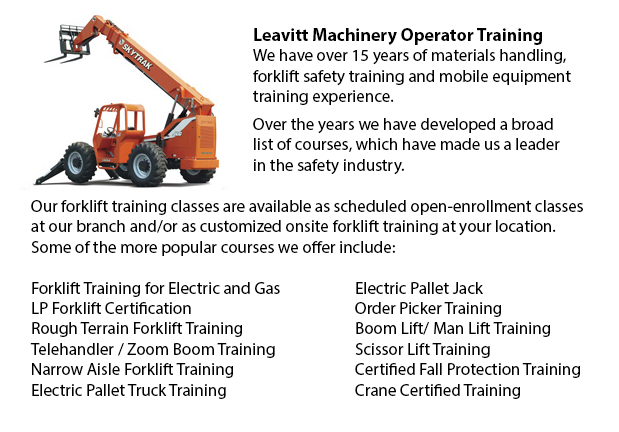
Zoom Boom Training Oakville - Zoom Boom Training focuses on correctly training prospective operators on variable reach forklifts. The training objectives consist of gaining the understanding of the equipments physics and to be able to define the job of the operator. This program follows North American safety standards for lift trucks. Zoom boom training and certification is obtainable at our site or at the company's location, provided there are a few trainees. Certification received upon successfully completing it is good for three years.
The telehandler or likewise known as a telescopic handler is similar in numerous ways to a common forklift or a crane. This versatile machinery is made together with a telescopic boom which can extend forward and lift upwards. A variety of attachments could be fitted on the end of the boom, like bucket, pallet forks, muck grab or lift table. It is popular in agriculture and industry settings.
The telehandler is a common utilized together with fork attachments to allow the shuttling of loads. Telehandlers have the advantage of being able to reach those inaccessible places that can't be reached by a standard forklift. Telehandlers are capable of removing loads that are palletized from within a trailer and putting them on high places such as rooftops. For some applications, they could be much more efficient and practical than a crane.
The disadvantage of the telehandler is its unsteadiness when lifting loads that are heavier. When the boom extends with a load, the unit becomes more and more unsteady. Counterweights situated at the back help, but don't solve the problem. As the working radius increases, the lifting capacity rapidly decreases. Some machinery come along with front outriggers which extend the lifting capacity whilst the machine is stationary.
A load chart helps the operator to know whether a given load is exceedingly heavy. Factors like for example load weight, boom angle and height are calculated. Several telehandlers have sensors that provide a warning or cut off further control if the unit is in danger of destabilizing.
-
Order Picker License Oakville
Order Picker License Oakville - Order preparation operation or order picking as it is more normally known is a method used within warehouse operations and consists of employees called order pickers. The order picker's task is to collect and take arti... More -
Forklift Operator Certification Oakville
Forklift Operator Certification Oakville - Forklift operator certification is normally needed for personnel working within industrial, warehouse or construction setting to guarantee the safe utilization of forklifts. Workplace training need to follow... More -
Scissor Lift Certification Oakville
Scissor Lift Certification Oakville - A lot of worksites and tradespeople like iron workers, welders and masons utilize scissor lift platforms to help them reach elevated work areas. The utilization of a scissor lift is usually secondary to their tra... More -
Forklift Training Courses Oakville
Forklift Training Courses Oakville - When forklift operator safety training is customized for illiteracy, training time is reduced by 50%. Train the trainer, forklift training certification and lift-truck operator driver safety training evaluation pr... More -
Manlift Training Oakville
Manlift Training Oakville - There are numerous manlift training programs which offer a review of the manlift machinery. The practicum portion of the training is one more vital portion of the course. In this section the trainee has chance to demonstra... More -
Boom Lift License Oakville
Boom Lift License Oakville - To operate an aerial boom lift, operators should be licensed through training that can be obtained utilizing both classroom sessions and practical training and by attaining a boom lift license. Instruction should be given... More -
Crane / Overhead Crane / Self-Erect Crane / Truck Mounted Crane / Hydraulic Cranes Training in Oakville
Bridge cranes or likewise called overhead cranes are actually a type of industrial material handling crane using a line and hook mechanism that runs on a horizontal beam running along two widely separated rails. Several overhead cranes could be seen... More -
Telehandler Training in Oakville
Telescopic handlers normally called telehandlers for short, are an extremely popular piece of heavy construction machinery. They are widely utilized in the construction and agricultural trades. These machines have maximum reaching ability and could g... More

Forklift Training Oakville
TOLL FREE: 1-888-254-6157
Oakville, Ontario
forklifttrainingoakville.com
Email Us
About Us


